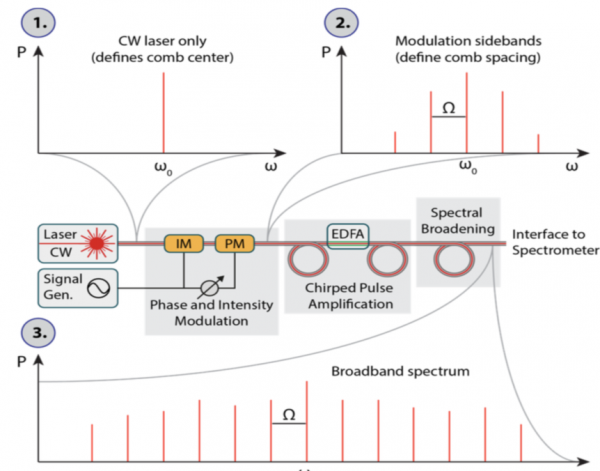Sky-Ruler
Radial velocity measurements play a crucial role for exoplanet detection and characterization. The sensitivity of the radial velocity method (and hence its potential of detecting low-mass Earth-like planets) is directly related to the capability of precisely calibrating the spectrometer in wavelength. Traditionally, gas lamps are used for spectrometer calibration. However aging and irregular spectral distribution of calibration lines limit their use in the given context. A novel method of calibration with potential of providing beyond state-of-the- art performance is based on optical laser frequency combs (LFCs). LFCs provide large sets of laser lines, equally spaced in optical frequency and, importantly, with their frequencies precisely and accurately known. In order to be resolvable by an astronomical spectrometer the frequency comb lines need to be separated in optical frequency by approximately 10 GHz or more. A frequency comb with such properties can provide an absolute wavelength calibration corresponding to an uncertainty of as low as cm/s. Furthermore, LFCs permits scanning the geometry of detector pixels (stitching block process) and deriving the instrument’s drift. Simultaneous observation and calibration avoids contamination of stellar spectra by otherwise strong emission lines of Hollow Cathode lamps.
Objectives of the project
The objective of the presently project was to implement a deployable near-infrared laser frequency comb (LFC) for spectrometer calibration and to test this source on an astronomical near-infrared spectrometer. Motivated by the advantages over competing technology (cf. above), the proposed LFC will be EOM based. The targeted laser line spacing is in the range form 10-15 GHz, the expected spectral coverage well in excess of 100 nm.
Recognizing the potential of EOM based light sources, CSEM (the Swiss Center for Electronics and Microtechnology) has already developed this technology for time and frequency metrology application including remote sensing and microwave photonics. Consequently, the present astronomical project will directly benefit this development at CSEM and can hence make rapid progress on the foreseen short 1-year time scale.

Illustration of FC generation based on electro-optic modulation (EOM). The procedure can be subdivided in 3 steps: 1) A continuous wave (CW) laser defines the center frequency of the comb, 2) EOM generates sidebands that define the spacing of the comb and 3) Spectral broadening extends the spectral coverage of the comb by generating more sidebands with the same spacing as initially defined by the EOM (EDFA: erbium-doped fiber amplifier).
The implemented system has been tested on the SPIROU near-infrared spectro-polarimeter presently integrated at IRAP (Toulouse). However, the implications of the project were not limited to SPIROU. Indeed, the project aimed at establishing a novel light source for near- infrared spectrometer calibration with impact beyond the scope of the project. In particular, the results of the project are of high relevance to the NIRPS@3.6-m and for the HIRES@E-ELT spectrographs. These instruments are intensively used to characterize the mass of transiting exoplanets orbiting late K and M dwarfs from ground-based surveys (NGTS, Speculoos, ExTRa) and space missions (CHEOPS, TESS, PLATO).
This project includes transfer of knowledge and technology from a non-PlanetS partner (CSEM) resulting in direct benefit for PlanetS projects with the aim to derive high-precision radial velocity, and to provide high quality spectra for exoplanetary atmosphere characterization. Vice versa the experience CSEM will make in the astronomical context will likely be of benefit for the development of EOM-based LFCs for general spectroscopy applications.
Contacts
PlanetS partner: François Wildi. and François Bouchy.
NON-PlanetS partner: Swiss Center for Electronics and Microtechnology (CSEM), Time and Frequency Section. Contacts: Tobias Herr (email) and Steve Lecomte (email), CSEM, Jaquet-Droz 1, CH-2000 Neuchâtel.

